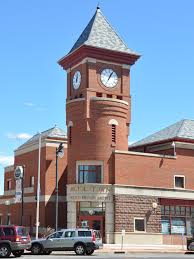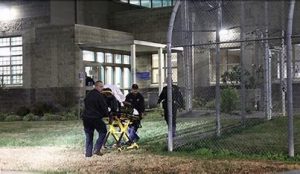
Overture. The Middletown Ct. Police Station—Bartok’s Sonata for two pianos and percussion.
Before beginning my job as a substitute teacher, I traveled to the police department for a fingerprint security check. The officer, a large friendly African American interviewed me.
“Where will you be teaching?”
“Middletown High School.”
“Oh,” he warningly replied. “Do you know that is a dangerous place? I would not let my son attend that school.”
My department chair, an elderly woman who had no interest in leadership but only in control, warned me not to wander in the classroom. “Stay in your chair or next to your desk,” she warned. Wrong: my first two weeks included an equal number of personal attacks: a forceful attempt to steal my phone, and wet spit on my shirt for enforcing a regulation.
I did not report either aggression to the SRO. I had learned that the detention room was just a secure space that fostered antisocial behavior, not remorse. For instance, the students played a blood game. They took turns hitting other students on the knuckles with a quarter. The first to bleed had to put money on the table. The last to bleed collected the money.
I informed the chair about this conduct. Unbelievably, she claimed that during her decades of teaching she had never heard of this. And she advised me to ignore it. After all, this was not a teaching responsibility.
One afternoon, I looked out the window. There were four police cars next to the building. I heard an uproar in the hallway. Several policemen were escorting a gaggle of students back to their classrooms. The students were taking a recess without permission.
For me this educational experience was disturbing. My chair told me to record the answers and grades on a test that was given by a teacher who had to leave for a medical emergency. The students had received credit for remembering that Japan was our enemy in World War 1. I checked their high school text. Their memory was right. But the text was wrong. The students did not care. The test was knowledge of the book. Perplexed, I complained to the chair who said the students correctly answered the question. It was not up to me to question the book. She refused to report this error to the publisher. This, and the refusal to teach evolution and other scientific facts added to my feelings of despair.
Where am I? Is this an educational institution?
Andante. A Low Security Prison for Juveniles—Stravinsky, Symphony in Three Movements.
President’ Johnson’s passage of the Civil Rights Act (1966) officially led to desegregation reforms through the country. The American Friends Service Committee took advantage of this funded federal program to send community workers to report on prisons behavior.
I was the leader of 10 college students sent to the prison in Lexington Ky. We were to live a few weeks there to observe desegregation progress. Unknowingly, the AFSC chose poorly if they were seeking infractions. The juvenile center was a model prison. We had few negative observations. This facility was a shining example for the reforms. The staff included many social workers and counsellors who worked with the youth to change their behavior. Furthermore, it had a low percentage of black prisoners. Unfortunately some were in maximum security cells.
For me, the most disheartening discovery was in revelations about the background of these youth. During the orientation, older residents interrogated the newbies regarding about their criminal history. Most of them had committed much worse crimes than they had been convicted for. Those caught for shop lifting or violent behavior had a personal list of car theft, arson, and rape.
While I was observing one such orientation, a resident asked the novice if he had sisters.
Answer: “none.”
The inquisitor’s face reflected shock, hurt, and anger. He never asked a question again.
Later, I asked the counsellor about this behavior.
“Oh,” he answered. “The kid hoped he could rake the inmate over. He himself had been forced to admit that he had raped his sisters. So, he was looking for another victim.”
The negative attitudes toward prisoners seemed more apparent before and after they were confined. Many female prisoners were punished for prostitution. Their prison record would further limit their ability to take part in society.
All former inmates would have difficulty in obtaining adequate employment, they could not vote, and their educational backgrounds and opportunities were squelched. Within the next five years their recidivism rate would be nearly 50%!
One positive escape: boys could enlist in the military. The girls had no comparable alternative to prison.
When the residents were released, they would return to a hostile community. For instance, once I went with a black student coworker to eat at a local restaurant. I had received a list of restaurants that accepted integrated customers. We chose a drive-in. Later, we realized we had not read the fine print that black customers had to remain in the car. Because I was driving an uncomfortable VW bug, we went into the restaurant. We waited for service. In several minutes the sheriff and his crew marched into the restaurant, ordering us to leave immediately. In the parking lot, I referred to President Johnson’s Civil Rights Act which protected integration. The Sheriff, who looked like an extra in a red neck film, pointed to his expansive chest declaring, “I am the law here.”
Without any evidence, I can only assume that if I had not been with him, and not identified myself with the local prison administration, the student would have been abused and even become a captive in the local jail.
To handle our anger, we went to a primarily black bar in a low-income neighborhood. Since we looked young, the bar tender asked to see our IDs. Looking at my driver’s license he informed me that it had expired. Because he had heard the story of my biracial encounter, he warned me that if the Sherrif had seen this ID, I would be in the county jail. For only the first time in my life I fainted!
Coda: Harlem. The Police Marching Band for military and patriotic events. (Never in East Harlem)
I lived at 76 E 111th Street for 18 months. My block was three avenues from the East River and one avenue from Third. The nearest subway station to the south was on 99th St. This Street was on the southern border of Harlem. It acted like a prison wall. Cabbies from Downtown often refused to cross the line when their fare wanted to travel uptown.
What is significant is that each street, like a cell block, had a clear identification. Mine was known for alcoholics; our neighboring blocks nurtured drugs and prostitution. One could usually recognize the various addicts by their violent behavior– the alcoholics engaged in group control, ownership of women, and simple theft. The addicts were dormant during the day. When they needed cash for a fix, they would engage in destructive behavior—breaking into a store crashing equipment and seeking to find something valuable to fence quickly for their addiction.
Harlem’s street grids marked clear boundaries from each other. Residents stayed on outdoor steps; gangs protected their neighborhoods, and police kept order.
The apartment sitters protected their domain. The sidewalks were unattended and often littered with paper wrappers, beer cans, and cigarette butts. Strangers walking past were seen with some suspicion—drug dealers? Police? Gangsters? The locals might yell at strangers. When I walked my girlfriend through the neighborhoods, I positioned her by the curb. I walked in front of the gawkers for her safety.
From my first-floor apartment window, I witnessed pick pockets, mugging, and rowdiness, Violent behavior was rife. One incident which amused me was to find a small washing machine placed on the roof of my VW. My most fuming gang member planted a nickel or dime bag under my door, then called the police. Later he murdered my replacement.
The mafia and police ran protection extortion rackets from the merchants and the vulnerable population. I detected several such incidents: four mafia characters demanding their regular payment from a restaurant owner, police attending a youthful late night party threatening people who were on parole or underage with arrest if they did not pay up.
There were many who isolated themselves. A beautifully dressed young woman invited me to her apartment. The rooms were decorated with bright wallpaper, high quality furniture, photographs, and displays of jewelry. A stunning bedroom harbored a four-poster bed. During our conversations, I learned she worked in Wall Street as a secretary. She was single. When asked what she thought of New York City and her job, she responded that it was the beginning and end of her subway commute. Other than that, her real life was in her apartment.
To me she appeared self-incarcerated.
Conclusion and Credits.
The symphonic program on incarceration was composed of three prominent types of cells: school, prison, neighborhoods.
Thanks to the Kagan Law Enforcement Think Tank for sponsoring this event.
Recent Photo of problems at the Lexington Juvenile Prison





Richard, this is a stunning piece of writing. I love how you link each story to a particular piece of music; putting it all together, you have your own dysfunctional piece of chamber music.
“No interest in leadership, only control…” That sentence really hit me, made me think – not just of the school environment where it applies all too often, but so many other disciplines as well. We are seeing it played out in Congress right now.
Your other examples are infuriating and heartbreaking. They show great empathy and strength on your part, and perhaps we’ve moved the needle a bit since that period, but I feel we are regressing and it makes me sick.
Thank you, as always, for sharing your interesting life with us.
Richard Kagan
10:39 AM (1 minute ago)
to Retrospect
Great feedback! I am pleased you thoroughly understood and felt my retrospect.
Just a footnote : Bartok was an emigrant fleeing from the Nazi threat to his Hungarian homeland. Stravinsky’sThird drew attention to Japanese aggression and Nazi storm troopers.
Yes, it is getting worse. The wealthy have built their own elite cells of gated communities with guards, walls, strict rules, and segregated athletic centers. For example, the reduction of public swimming pools is a result of the response to integrated swimming, and the opposition to public services paid by taxes. I have been kicked off of one non-public tennis court for making too much noise. How can I not be quiet when I win?LOL
And thanks for the musical explanation. I sing (a lot) of the classical repertoire, but was not familiar with the works you chose here. I know the composers, but not their personal histories, which makes your piece all the more fascinating.
Thanx for your very creatively written Prison story Richard, despite its depressing reveals.
Through my involvement with an advocacy group for incarcerated youth, I have friends who teach kids serving time and those awaiting adjudication in juvenile detention centers, and also friends who work with inmates at the infamous Rikers. From them I’ve heard tales like yours, as well as some inspirational ones thankfully.
Bravo for the work you did!
Yes, there are some positive even inspirational. My wife, President of a Ct. community college, worked jointly with Wesleyan University to provide courses for adult prisoners–men and women. These residents could receive college credit which could and did lead to a full degree. My wife, Anna, attended a seminar that included the study of Kafka. (rather appropriate). She reported to me that the students’ response and discussion were on a very high intellectual level, which provided evidence that they had carefully read the materials.
Great insights into a variety of incarceration scenarios. You have experienced a lot that is difficult and raw but are able to tell the story. Thanks for doing that. So much that needs to change.
Thanks for your appreciation. I, of course, have a whole list of reforms, but this prompt is about me and not about what to do about it. Charlie advised me that my purpose is to write about my own observations and emotions, and not use my historical and sociological skills to propose solutions. Thise prompts have encouraged me to tell stories rather than to write analytical articles that keep my life private. I appreciate this opportunity.
I like how you structured your writing around three types of prison: a failing school, a prison for juveniles, and a neighborhood. Bravo to you for fighting the good fight. So many are trapped in the cradle to prison pipeline, and sadly schools play a role in perpetuating this.
I was going along enjoying this story quite a bit until that little understated aside that your successor was murdered. Whoa. Anyway, a very good exploration of the prompt.
Glad you were shocked. So was I. This was not the only time I had such a response–mainly to threats by gun, knife, and mugging. I am glad I did not inhabit any of these sites. I feel very lucky to be alive writing to you today.